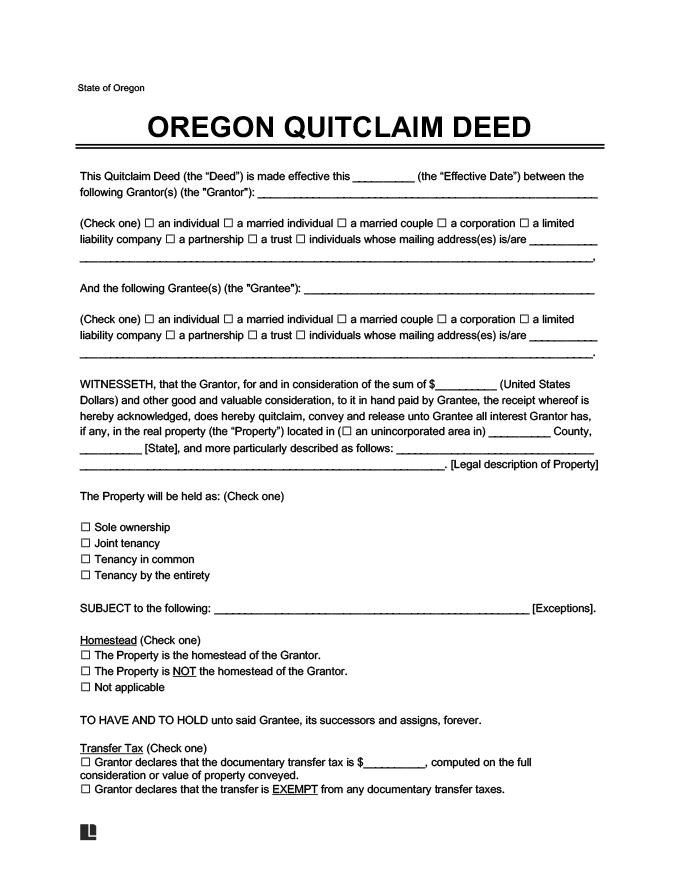An Oregon quitclaim deed enables property transfer without warranty of title, relieving the grantor (or seller) of legal liability for any title or ownership defects.
This method accommodates transfers with little or no consideration or changes to an existing title, commonly used in scenarios such as conveying property to a business, transferring assets into trusts, facilitating divorce settlements, and incorporating real estate into estate planning strategies.
Legal Framework
State laws establish the language, requirements, and effects of transferring property using a quitclaim deed. ORS § 93.865 sets legal grounds for using quitclaim deeds to convey real estate.
Per ORS § 93.140, real estate conveyances do not imply covenants or guarantees unless written as a warranty deed under ORS § 93.850. Unlike quitclaim deeds, warranty deeds must include specific language to establish warranty exclusions.
Legal Description
Real estate transfers must include a legal description of the property being conveyed, consistent with ORS § 308.240. For a quitclaim deed, you can usually pull the property description from the original deed. The following methods can legally describe real property:
- Subdivisions.
- Lots, blocks, and additions.
- Boundaries by metes and bounds.
- Plat or map parcels and partitions.
- Book and page reference to previously recorded legal documents.
Required property disclosure statements for sales agreements, earnest money receipts, and fee title property transfers are listed under ORS § 93.040.
ORS § 93.120 also states that any real estate conveyance automatically transfers the full interest of the grantor in the property. However, the grantor can limit the interest by expressing the amount they wish to transfer in clear terms within the quitclaim deed.
Signing
- Per ORS § 93.010, the deed must include the grantor’s signature. The grantor’s attorney or lawful agent can sign on their behalf if necessary.
- The signature must be witnessed and acknowledged by a notary, judge, or justice of the peace, per ORS § 93.410. Statutory forms for notary certificates can be found under ORS § 194.285.
Terminology
- Per ORS § 93.865, a quitclaim deed may include the following language: “[Grantor] releases and quitclaims to [Grantee] all right, title, and interest in and to the following described real property: [Insert legal description].”
- While you can modify the language as needed, a legally binding document must include the term “release and quitclaim.” This allows the grantor to release their rights to the property without warranty of title or ownership.
- After the property description, the quitclaim should include appropriate disclosures per ORS § 93.040, verbatim. A statement of consideration must be listed on the face of the deed, consistent with ORS § 93.030.
Filing
- According to ORS § 93.635, the grantor must record the deed with the county recorder where the property is located within 15 days of signing the deed.
- Avoid unnecessary delays or complications by ensuring your document meets formatting and content requirements.
Validity Requirements
State law requires highly specific formatting for quitclaim deeds and other documents submitted to the county recorder. Requirements under ORS § 205.232 and ORS § 205.135 establish that the documents must be:
- Typed, written, or printed in 8-point or larger font.
- Printed on paper no greater than 8 ½ in. x 14 in.
- On quality paper that can create clear copies.
- Legible and capable of producing a readable photocopy.
Each county recorder’s office may have different formatting and submission requirements. Check with your county recorder prior to submitting your deed to ensure it is formatted correctly.
Content Requirements
To ensure continuity for real estate transfers, Oregon has established multiple requirements for recorded documents, including quitclaim deeds. Content guidelines include:
-
- Transaction labels (ORS § 205.236).
- Grantor and grantee names (ORS § 205.125).
- The return address for the recorded deed (ORS § 205.180).
- Statement of consideration (ORS § 93.030).
- Tax statement information, if applicable (ORS § 93.260).
- Lien information, if applicable (ORS § 205.125).
- Mortgage or trust beneficiary information, if applicable (ORS § 205.234).
- Property legal description (ORS § 205.160).
Most of the above details must be included on the first page of the deed. Failure to do so may result in additional recording fees at the time of filing. Your county recorder may have other requirements, so check with them before you proceed.
Quitclaim Deeds vs. Other Property Transfer Methods
| Quitclaim Deed | Transfers property from the owner to the recipient without warranty of title. Should title defects arise, the new owners will be responsible for resolving them. |
| Warranty and Special Warranty Deeds | ORS § 93.850 establishes the terminology and effect of warranty deeds. ORS § 93.855 provides terminology and legal grounds for special warranty deeds. |
| Joint Property | ORS § 93.180 outlines how a property can be co-owned. Co-ownership allows the interest to pass to the other owner in the event of one owner’s death. |
| Title Insurance | This method may help defray the costs associated with a title defect for an initial premium payment, per ORS § 731.190. |
| Bargain and Sale Deed | Per ORS § 93.860, it transfers property without warranty but includes any interest in the property acquired by the grantor after the transfer. |
| Transfer on Death Deed | Per ORS § 93.967 and ORS § 93.969 transfer on death (TOD) deeds convey property from the owner to an heir or beneficiary upon the owner’s death. |
